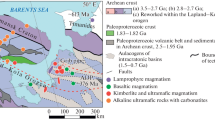Abstract
The results of study secondary crystallized melt inclusions in olivine of a sheared peridotite xenolith from the Komsomolskaya–Magnitnaya kimberlite pipe (Upper Muna field, Yakutia) are reported. Monticellite, phlogopite, tetraferriphlogopite KMg3(Fe3+)Si3O10(F,Cl,OH), apatite, aphthitalite K3Na(SO4)2, burkeite Na6CO3(SO4)2, and carbonates, namely calcite, nyerereite (Na,K)2Ca(CO3)2, shortite Na2Ca2(CO3)3, and eitelite Na2Mg(CO3)2, were detected among the daughter minerals of the melt inclusions by the method of confocal Raman spectroscopy. The abundance of alkali carbonates in the inclusions indicates the alkali–carbonate composition of the melt. Previously, identical inclusions of alkali–carbonate melt were reported in olivine of sheared peridotites from the Udachnaya pipe (Daldyn field). Melt inclusions in sheared peridotites are the relics of a crystallized kimberlite melt that penetrated into peridotites either during the transport of xenoliths to the surface or directly in the mantle shortly prior to the entrapment of xenoliths by the kimberlite magma. If the second scenario took place, the finds of alkali–carbonate melt inclusions in sheared peridotites carried from different mantle depths in the Udachnaya and Komsomolskaya–Magnitnaya kimberlite pipes indicate a large-scale metasomatic alteration of the lithospheric mantle of the Siberian Craton by alkaline-carbonate melts, which preceded the kimberlite magmatism. However, regardless of which of the two models proposed above is correct, the results reported here support the alkali–carbonate composition of primary kimberlite melts.




Similar content being viewed by others
REFERENCES
P. Schiano and R. Clocchiatti, Nature 368 (6472), 621–624 (1994).
M.-L. Frezzotti, Lithos 55 (1–4), 273–299 (2001).
A. V. Golovin and V. V. Sharygin, Russ. Geol. Geophys. 48 (10), 811–824 (2007).
D. A. Zedgenizov, A. L. Ragozin, V. S. Shatsky, and W. L. Griffin, Contrib. Mineral. Petrol. 173, 84 (2018).
A. V. Golovin, I. S. Sharygin, and A. V. Korsakov, Chem. Geol. 455, 357–375 (2017).
A. V. Golovin, I. S. Sharygin, A. V. Korsakov, V. S. Kamenetsky, and G. M. Yaxley, Chem. Geol. 483, 261–274 (2018).
A. V. Golovin, I. S. Sharygin, A. V. Korsakov, V. S. Kamenetsky, and A. Abersteiner, J. Raman Spectrosc. 51, 1849–1867 (2020).
A. M. Dymshits, I. S. Sharygin, V. G. Malkovets, I. V. Yakovlev, A. A. Gibsher, T. A. Alifirova, S. S. Vorobei, S. V. Potapov, and V. K. Garanin, Minerals 10, 549 (2020).
G. G. Lemmlein, Crystals: Morphology and Genesis (Nauka, Moscow, 1973) [in Russian].
E. Roedder, Fluid Inclusions (Mineral. Soc. Am., 1984).
I. S. Sharygin, A. V. Golovin, A. V. Korsakov, and N. P. Pokhilenko, Eur. J. Mineral. 25 (5), 825–834 (2013).
I. S. Sharygin, K. D. Litasov, A. Shatskiy, O. G. Safonov, A. V. Golovin, E. Ohtani, and N. P. Pokhilenko, Chem. Geol. 455, 44–56 (2017).
J. K. Russell, L. A. Porritt, Y. Lavallee, and D. B. Dingwell, Nature 481, 352–356 (2012).
R. S. Stone and R. W. Luth, Contrib. Mineral. Petrol. 171, 63 (2016).
A. Shatskiy, K. Litasov, I. Sharygin, and E. Ohtani, Gondwana Res. 45, 208–227 (2017).
V. S. Kamenetsky, M. B. Kamenetsky, A. V. Golovin, V. V. Sharygin, and R. Maas, Lithos 152, 173–186 (2012).
V. S. Kamenetsky, A. V. Golovin, R. Maas, A. Giuliani, M. B. Kamenetsky, and Y. Weiss, Earth-Sci. Rev. 139, 145–167 (2014).
M. G. Kopylova, M. Gaudet, S. I. Kostrovitsky, A. G. Polozov, and D. A. Yakovlev, J. Volcanol. Geotherm. Res. 327, 116–134 (2016).
I. S. Sharygin, A. V. Golovin, and N. P. Pokhilenko, Dokl. Earth Sci. 436 (6), 301–308 (2011).
A. G. Polozov, S. S. Sukhov, M. A. Gornova, and S. N. Grishina, in Proc. Int. Kimberlite Conf. (Frankfurt, 2008), Vol. 9. https://doi.org/10.29173/ikc3481.
Funding
This study was financially supported by the Russian Foundation for Basic Research, project no. 20-35-70058, as well as was supported by the state assignment projects of the Institute of the Earth’s Crust and Sobolev Institute of Geology and Mineralogy, Siberian Branch, Russian Academy of Sciences.
Author information
Authors and Affiliations
Corresponding author
Additional information
Translated by A. Bobrov
Rights and permissions
About this article
Cite this article
Sharygin, I.S., Golovin, A.V., Dymshits, A.M. et al. Relics of Deep Alkali–Carbonate Melt in the Mantle Xenolith from the Komsomolskaya–Magnitnaya Kimberlite Pipe (Upper Muna Field, Yakutia). Dokl. Earth Sc. 500, 842–847 (2021). https://doi.org/10.1134/S1028334X21100147
Received:
Revised:
Accepted:
Published:
Issue Date:
DOI: https://doi.org/10.1134/S1028334X21100147




